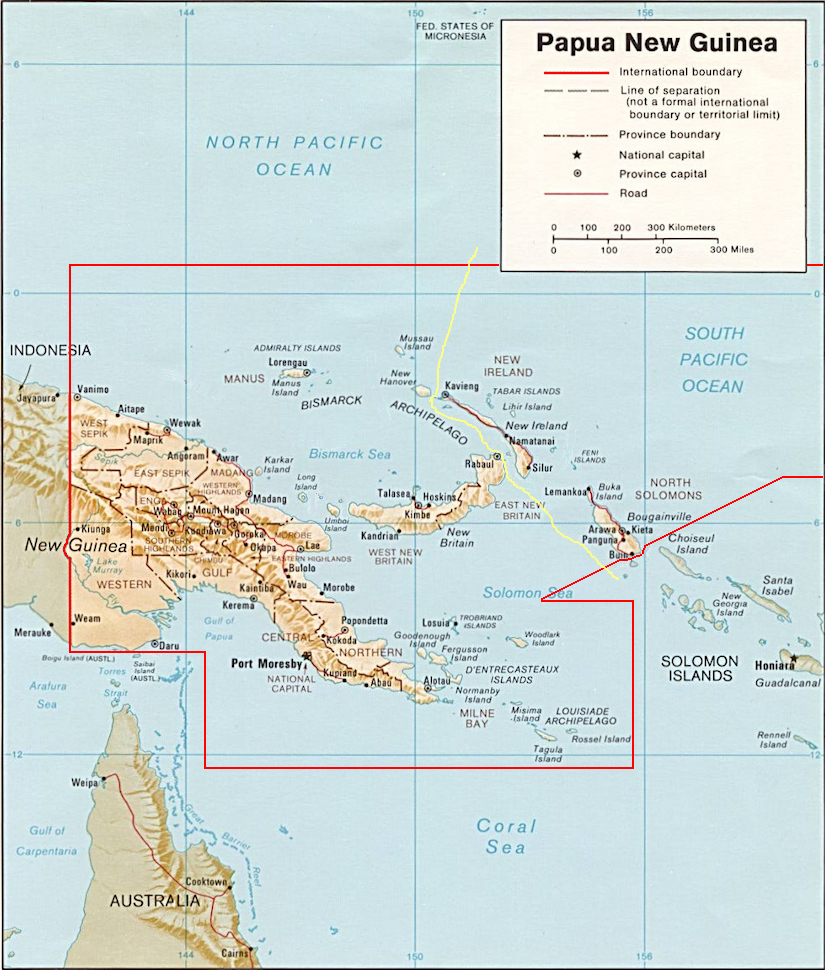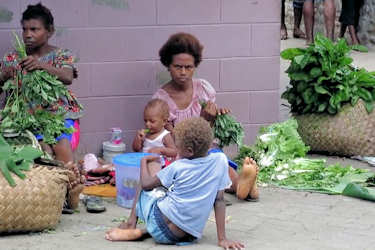Papua New Guinea

Historie
The prehistory of Papua New Guinea can be traced back to about 60.000 years ago when people first migrated
towards the Australian continent. Agriculture was independently developed in the New Guinea highlands around
7000 BC, making it one of the few areas in the world where people independently domesticated plants. Traders
from Southeast Asia had visited New Guinea beginning 5.000 years ago to collect bird of paradise plumes
A major migration of Austronesian speaking peoples to coastal regions of New Guinea took place around 500 BC.
The first Europeans to sight New Guinea were probably the Portuguese and Spanish navigators sailing in the
South Pacific in the early part of the 16th century. In 1526–27, the Portuguese explorer Jorge de Menezes
accidentally came upon the principal island and is credited with naming it Papua, a Malay word for the
frizzled quality of Melanesian hair. The term New Guinea was applied to the island in 1545 by a Spaniard,
Yñigo Ortiz de Retez, because of a resemblance between the islands' inhabitants and those found on the
African Guinea coast.
Although European navigators visited the islands and explored their coastlines thereafter, little was known of
the inhabitants by Europeans until the 1870s, when Russian anthropologist Nicholai Miklukho-Maklai made a
number of expeditions to New Guinea, spending several years living among native tribes, and described their way of
life in a comprehensive treatise.
In the nineteenth century, Germany ruled the northern half of the country as a colony for some decades, beginning
in 1884, as German New Guinea. The southern half was colonised in the same year by the United Kingdom as
British New Guinea. In 1904 with the passage of the Papua Act, it transferred this territory to the
newly formed Commonwealth of Australia, which took on its administration. Additionally from 1905,
British New Guinea was renamed the Territory of Papua.
The New Guinea campaign (1942–1945) was one of the major military campaigns of World War II. After World
War II the two territories were combined into the Territory of Papua and New Guinea, which later was simply referred
to as "Papua New Guinea".
The nation established independence from Australia on 16 September 1975, and maintain close ties. (Australia
continues as the largest aid donor to Papua New Guinea).
The 1977 national elections confirmed Michael Somare as Prime Minister at the head of a coalition led by the Pangu
Party. However, his government lost a vote of confidence in 1980 and was replaced by a new cabinet headed by Sir
Julius Chan as prime minister.
The 1982 elections increased Pangu's plurality, and parliament again chose Somare as prime minister. In November 1985, the
Somare government lost another vote of no confidence, and the parliamentary majority elected Paias Wingti, at the head
of a five-party coalition, as prime minister. A coalition, headed by Wingti, was victorious in very close elections in July 1987.
In July 1988, a no-confidence vote toppled Wingti and brought to power Rabbie Namaliu, who a few weeks earlier had
replaced Somare as leader of the Pangu Party.
Such reversals of fortune and a revolving-door succession of prime ministers continue to characterize Papua New Guinea's national
politics. A plethora of political parties, coalition governments, shifting party loyalties and motions of no confidence in the
leadership all lend an air of instability to political proceedings.
In early June 2012, Australia and New Zealand sent troops to Papua New Guinea to help keep order in general elections. The two
countries issued a joint statement which said, "Australia and New Zealand are providing practical support in response to a
request by Papua New Guinea authorities to assist them with the conduct of a safe, free and fair election."
Peter O'Neill was sworn in as prime minister on Aug. 3, 2012, after a 94-12 vote in parliament. Achieved with the support
of his once-rival Michael Smore, known as the "Grand Chief"
O'Neill's election marked the hopeful start of a new period of stability and unity.
I have visited Papua New Guinea in april 2015.
It was part of the West Pacific Odessey
On that trip i have seen
Bismarck Archipelago
Please let me know when you're having questions.
i would be pleased to help you.
Things to do and other tips
